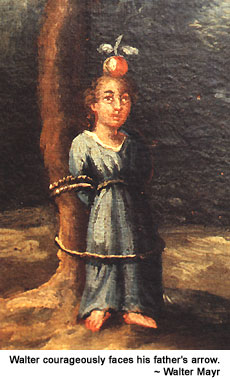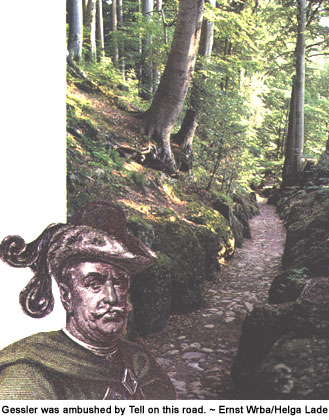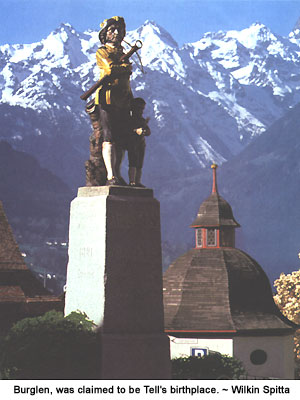Swiss wars of independence
"Look, father!" the young boy calls. "There is a hat on top of that pole." Unimpressed, the man replies, "What has that hat to do with us? Come on!" A child's innocent question; a father's indifferent response. And yet, history was about to be made.The scene is the marketplace of Altdorf in Canton Uri, one of the three forest cantons, or states, of the Swiss heartland. It is the early 1300's; Uri, Schwyz, and Unterwalden have only recently forged an alliance to settle disagreements among themselves by arbitration and not by warfare and to unite for mutual defense against outsiders. For centuries the cantons have been ruled by the distant Holy Roman emperors, independence being but a dream of the proud peasants who toil in nearly inaccessible mountain valleys.
 William Tell is such a lover of freedom, and it is he on this day who scorns the hat placed on a pole by Hermann Gessler, the autocratic governor sent from Vienna. When he is away, Gessler has decreed, the hat represents his authority. All passersby must pause to salute it. Tell's casual disrespect is observed by a mercenary named Friesshart, who stops him with a leveled pike. "Halt there!" he cries. I charge you in the name of the emperor." Threatened with arrest, Tell is momentarily at a loss. Walter, his son, runs for help and soon returns with a number of other peasants who share his father's indignation at the outrageous demand of the governor. As the argument between Tell and Friesshart is about to erupt into violence, a figure on horseback appears. "Make way for the governor!" comes a shout.
William Tell is such a lover of freedom, and it is he on this day who scorns the hat placed on a pole by Hermann Gessler, the autocratic governor sent from Vienna. When he is away, Gessler has decreed, the hat represents his authority. All passersby must pause to salute it. Tell's casual disrespect is observed by a mercenary named Friesshart, who stops him with a leveled pike. "Halt there!" he cries. I charge you in the name of the emperor." Threatened with arrest, Tell is momentarily at a loss. Walter, his son, runs for help and soon returns with a number of other peasants who share his father's indignation at the outrageous demand of the governor. As the argument between Tell and Friesshart is about to erupt into violence, a figure on horseback appears. "Make way for the governor!" comes a shout.Gessler demands to know what has happened and is displeased with Friesshart's report. He knows Tell by reputation as a master marksman with bow and arrow, a skill young Walter proudly confirms: ''My father can shoot an apple from a tree at a hundred yards." A cruel smile flashes across the oppressor's face. In punishment for his disrespect to the hat, Tell is ordered to demonstrate his prowess -by shooting an an apple not from a tree but from atop Walter's head. A horrified hush falls over the crowd, but Tell's pleas for mercy are ignored by Gessler. "Shoot, or die!" Gessler thunders. "You and the boy."
Slowly regaining his composure, Tell prepares for the dreadful ordeal. Walter, in supreme trust of his father, scorns a blindfold. But after he has placed the arrow in his crossbow and begun to take aim, Tell pauses, lowers the weapon, removes a second arrow from his quiver, and puts it in his belt. Only then does he perform the unpleasant task. The arrow splits the apple on Walter's head neatly in half, the boy runs to his father, who picks him up and tenderly presses him to his chest. Though complimenting the marksman, Gessler has guessed why he readied the second arrow. Tell confirms the governor's suspicion: "If my first arrow had my dear child struck, the second arrow I had aimed at you. And, be assured, I should not then have missed."
Igniting an Insurrection
For his insolence, William Tell is taken into custody by the governor. "I'll have you carried hence and safely penned where neither sun nor moon shall reach your eyes," Gessler thunders. "Thus from your arrows I'll be free."But as the prisoner is being transported by boat across Lake Lucerne, a gale turns the waters into raging whirlpools. Recalling that Tell is also an experienced coxswain, the oarsmen beg Gessler to untie the ropes that bind him so that he can take charge of the helm. Tell skillfully steers the boat toward shore and, as it passes a rocky ledge, jumps to his freedom.
Now a fugitive, Tell plots his revenge, vowing to put an end to Gessler's capricious cruelty. Knowing the route that the governor must take to his castle, the marksman stations himself behind brushwood overlooking a depressed road through the forest. "He has no choice but through this sunken way to come to Kiissnacht, mutters Tell. " 'Tis here I'll do it."
Once more, Tell's arrow finds its target. Gessler falls to the ground, finding time before he dies only to croak out the assassin's name. "You know the marksman, you need not seek another, "Tell cries in glee from atop a rock. "Free are the homesteads, innocence is safe, and you will do the country no more harm." It is the opening shot in the wars for Swiss independence.
History or Drama?
The apple shot from a son's head, the escape of a prisoner during a storm on the waters, the assassination of a tyrant - such is the plot of William Tell, a verse drama by Friedrich von Schiller. It was first performed in 1804, some 500 years after the events it includes are supposed to have taken place. But Schiller was not merely inventing a tale to make a thrilling stage presentation. He based his play on narratives dating back to the late 1400's that, in turn, seem to have been based on earlier oral traditions.The first reference in print to William Tell is in a ballad published in 1477, Song of the Origin of the Confederation. Four of its 29 stanzas celebrating the achievement of Swiss unity and independence in the previous century deal with the story of the marksman forced to shoot an apple from his son's head. There is no mention of a governor named Gessler, a hat placed on a pole, Tell's escape from captivity, or the assassination at Kiissnacht. Such details are found in another work of approximately the same date.
Sometime between 1467 and 1474 an anonymous notary at Sarnen in Canton Unterwalden gathered a number of historical stories apparently handed down by word of mouth into a collection known as The White Book because of the color of its parchment binding. In this version Gessler is named, though identified as a bailiff. He demands respect for his hat, forces a marksman to shoot an apple from his son's head for failure to make obeisance to it, arrests him for the threat of the second arrow, and is assassinated by the escaped prisoner. However, the marksman called Thall not Tell - is not linked to the rebellion leading to Swiss independence.
A Long Literary Tradition
A leading scholar of early Swiss history asked how Tell, or Thall, came to feature so prominently in two works published more than a century and a half after the outbreak of the Swiss insurrection. Earlier historians of the movement made no mention of such a hero. The answer, he suggested, lay beyond the borders of Switzerland.Until the end of the Middle Ages an ordeal was generally accepted throughout Europe as the means of establishing guilt or innocence. If guilty, the accused would perish; if innocent, he would survive the ordeal. God would so will it to happen, and men would be expected to respect his verdict. The theme of a marksman put to the test of shooting an apple from his child's head is found in the oral traditions of countries throughout Europe, including Germany, Denmark, Norway, and Iceland. The old English ballad of William of Cloudesly is remarkably similar to the 1477 Song of the Origin of the Confederation:

I have a sonne is seven yere olde; He is to me full deare; I will hyrn tye to a stake, All shall see that be here; And lay an apple upon hys head And go syxe score paces huyrn fro, And I my selfe, with a brode arrow, Shall cleve the apple in two.Cloudesly's king, like Tell's governor, expresses the fear that the marksman's arrow will in time be turned on him.
The work to which the tale of the Swiss William Tell bears the strongest resemblance, however, is Gesta Danorum, a 12th-century Danish history by one Saxo Grammaticus. During a drinking bout the hero, Toko, or Tiki, boasts of his skill at archery -for which the cruel king Harald Bluetooth puts him to the test of shooting an apple from his son's head. As does Tell, Toko reserves a second arrow for the tyrant in case he misses. In a subsequent rebellion the marksman slays the king in a forest ambush. Whoever first wrote about William Tell may well have had Toko in mind as a model for the Swiss master marksman who defied a cruel oppressor.
Chipping Away at a Legend
As early as the 16th century the story of William Tell fell under suspicion. A chronicler of Canton Saint Gall noted that the three forest cantons "tell strange things in regard to their age and origin.... I suspect that much is fabled, and some again may not be likened to the truth." Francois Guilliman included William Tell in his 1607 history De Rebus Helvetiorum, even embellishing the tale with some details of his own. But in a letter to a friend, he surprisingly confessed that, after mature reflection, he had reached the conclusion that it was but a fable - invented to nourish hatred of the Austrians.In 1760 a Swiss pastor named Uriel Freudenberg published a pamphlet linking William Tell to the Danish legendary hero; the officials of Uri ordered the blasphemous work publicly burned. A rebuttal in defense of Tell was published by a writer of Lucerne, and two noted historians of the day issued declarations in support of the tradition - though one of them privately expressed his reservations about the authenticity of the beloved tale. In composing his drama, Schiller had to confess that he was taking literary license in making William Tell the central figure in the struggle for Swiss independence.
The final blow to the legend was struck by the historian Joseph Eutych Kopp in three scholarly works published between 1835 and 1853. After thoroughly searching the archives of the three forest cantons, he reached the conclusion that William Tell had never existed. The public outcry was about what could be expected if an American historian tried to prove that George Washington was only a legendary figure. Nonetheless, in time, most Swiss came to accept the fact that there had been no William Tell and that there was no one heroic father of Swiss independence. The country's best-loved story, unfortunately, had no basis in fact.
The Emergence of Switzerland
Though lacking a central heroic figure, the Swiss struggle for independence is not without drama. The pact signed in 1291 by Uri, Schwyz, and Unterwalden was not a declaration of independence - though the three forest cantons were restive under the rule of the Holy Roman emperors. They particularly resented the fact that their lands were treated as family property by the ruling Hapsburgs. Early in 1314 Duke Leopold of Hapsburg invaded the cantons, determined to assert his family's authority over the defiant mountaineers. An inferior force of Schwyz foot soldiers, joined by some Uri confederates, trapped the Austrians in a mountain pass, hurled boulders down at them, and decisively defeated them at the Battle of Morgarten on November 15, 1315. In recognition of the role played by Canton Schwyz at Morgarten the confederation came to be known as Schweiz (in German), Suisse (in French), Svizzera (in Italian), or Switzerland (in English).
Early in 1314 Duke Leopold of Hapsburg invaded the cantons, determined to assert his family's authority over the defiant mountaineers. An inferior force of Schwyz foot soldiers, joined by some Uri confederates, trapped the Austrians in a mountain pass, hurled boulders down at them, and decisively defeated them at the Battle of Morgarten on November 15, 1315. In recognition of the role played by Canton Schwyz at Morgarten the confederation came to be known as Schweiz (in German), Suisse (in French), Svizzera (in Italian), or Switzerland (in English).In the wake of this victory the three forest cantons were joined by other breakaway provinces until, by 1353, there were eight members of the confederation, including the cities of Lucerne, Zurich, and Bern. The Hapsburgs again intervened, hoping to check the tide of Swiss independence, but they were again defeated in two critical battles. In 13 94 the Austrians signed a 20-year truce with the confederation that, in effect, acknowledged Swiss independence.
The Immortal Tell
Like all other peoples, the Swiss need their heroes, and the legendary William Tell is remembered at numerous locations throughout the country. Visitors can see the rocky ledge on Lake Lucerne to which he leaped to freedom, the sunken road near Kiissnacht where he ambushed Gessler, and, of course, the marketplace at Altdorf where he shot the apple from Walter's head.As late as 1569, two and a half centuries after the alleged trial by ordeal, a lime tree stood in Altdorf's marketplace. According to tradition, Walter had faced his father from beneath its branches. In reality, it marked the place where judicial inquiries were held. Legal documents of the time carried the notation that they were signed "under the lime tree at Altdorf." When the tree withered, died, and was cut down, a fountain was erected on the spot.
As for the hat on a pole, it seems to have been unique to the Swiss version of a trial by ordeal. Since a number of Swiss families show a hat in their coat of arms, a modern historian speculates that a hat somehow symbolized authority. Putting a hat on a post - far from being the whim of a tyrant - was perhaps merely the way in which an official such as a mayor announced his presence at a public gathering.

